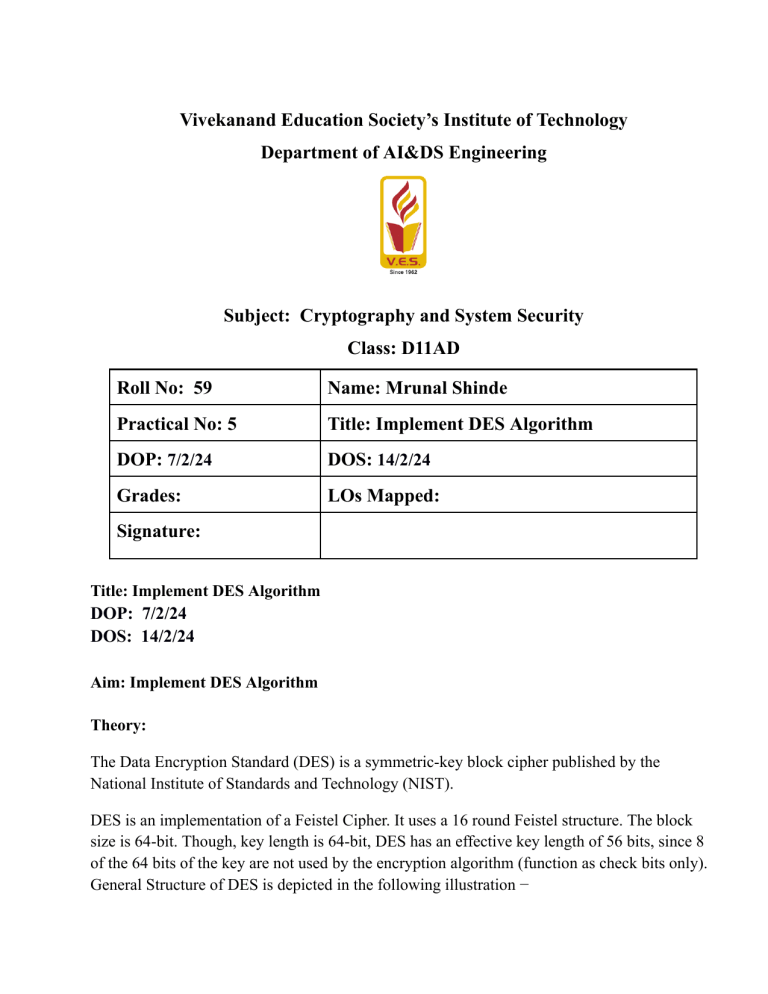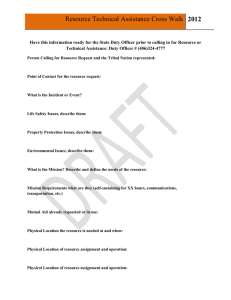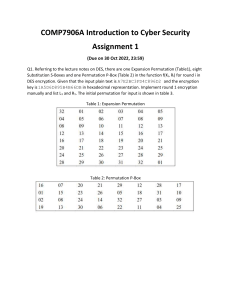
Vivekanand Education Society’s Institute of Technology
Department of AI&DS Engineering
Subject: Cryptography and System Security
Class: D11AD
Roll No: 59
Name: Mrunal Shinde
Practical No: 5
Title: Implement DES Algorithm
DOP: 7/2/24
DOS: 14/2/24
Grades:
LOs Mapped:
Signature:
Title: Implement DES Algorithm
DOP: 7/2/24
DOS: 14/2/24
Aim: Implement DES Algorithm
Theory:
The Data Encryption Standard (DES) is a symmetric-key block cipher published by the
National Institute of Standards and Technology (NIST).
DES is an implementation of a Feistel Cipher. It uses a 16 round Feistel structure. The block
size is 64-bit. Though, key length is 64-bit, DES has an effective key length of 56 bits, since 8
of the 64 bits of the key are not used by the encryption algorithm (function as check bits only).
General Structure of DES is depicted in the following illustration −
Since DES is based on the Feistel Cipher, all that is required to specify DES is −
Round function
Key schedule
Any additional processing − Initial and final permutation
Initial and Final Permutation
The initial and final permutations are straight Permutation boxes (P-boxes) that are inverses of
each other. They have no cryptography significance in DES. The initial and final permutations
are shown as follows −
Round Function
The heart of this cipher is the DES function, f. The DES function applies a 48-bit key to the
rightmost 32 bits to produce a 32-bit output.
Expansion Permutation Box − Since right input is 32-bit and round key is a 48-bit, we first
need to expand right input to 48 bits. Permutation logic is graphically depicted in the following
illustration −
The graphically depicted permutation logic is generally described as table in DES
specification illustrated as shown −
XOR (Whitener). − After the expansion permutation, DES does XOR operation on the
expanded right section and the round key. The round key is used only in this operation.
Substitution Boxes. − The S-boxes carry out the real mixing (confusion). DES uses 8 S-boxes,
each with a 6-bit input and a 4-bit output. Refer the following illustration −
The S-box rule is illustrated below −
There are a total of eight S-box tables. The output of all eight s-boxes is then combined
in to 32 bit section.
Straight Permutation − The 32 bit output of S-boxes is then subjected to the straight
permutation with rule shown in the following illustration:
Key Generation
The round-key generator creates sixteen 48-bit keys out of a 56-bit cipher key. The process of
key generation is depicted in the following illustration −
The logic for Parity drop, shifting, and Compression P-box is given in the DES description.
DES Analysis
The DES satisfies both the desired properties of block cipher. These two properties make cipher
very strong.
Avalanche effect − A small change in plaintext results in the very great change in the
ciphertext.
Completeness − Each bit of ciphertext depends on many bits of plaintext.
During the last few years, cryptanalysis have found some weaknesses in DES when key
selected are weak keys. These keys shall be avoided.
DES has proved to be a very well designed block cipher. There have been no significant
cryptanalytic attacks on DES other than exhaustive key search.
Code & Output :
def hex2bin(s):
mp = {'0': "0000",
'1': "0001",
'2': "0010",
'3': "0011",
'4': "0100",
'5': "0101",
'6': "0110",
'7': "0111",
'8': "1000",
'9': "1001",
'A': "1010",
'B': "1011",
'C': "1100",
'D': "1101",
'E': "1110",
'F': "1111"}
bin = ""
for i in range(len(s)):
bin = bin + mp[s[i]]
return bin
def bin2hex(s):
mp = {"0000": '0',
"0001": '1',
"0010": '2',
"0011": '3',
"0100": '4',
"0101": '5',
"0110": '6',
"0111": '7',
"1000": '8',
"1001": '9',
"1010": 'A',
"1011": 'B',
"1100": 'C',
"1101": 'D',
"1110": 'E',
"1111": 'F'}
hex = ""
for i in range(0, len(s), 4):
ch = ""
ch = ch + s[i]
ch = ch + s[i + 1]
ch = ch + s[i + 2]
ch = ch + s[i + 3]
hex = hex + mp[ch]
return hex
# Binary to decimal conversion
def bin2dec(binary):
binary1 = binary
decimal, i, n = 0, 0, 0
while(binary != 0):
dec = binary % 10
decimal = decimal + dec * pow(2, i)
binary = binary//10
i += 1
return decimal
def dec2bin(num):
res = bin(num).replace("0b", "")
if(len(res) % 4 != 0):
div = len(res) / 4
div = int(div)
counter = (4 * (div + 1)) - len(res)
for i in range(0, counter):
res = '0' + res
return res
def permute(k, arr, n):
permutation = ""
for i in range(0, n):
permutation = permutation + k[arr[i] - 1]
return permutation
def shift_left(k, nth_shifts):
s = ""
for i in range(nth_shifts):
for j in range(1, len(k)):
s = s + k[j]
s = s + k[0]
k=s
s = ""
return k
def xor(a, b):
ans = ""
for i in range(len(a)):
if a[i] == b[i]:
ans = ans + "0"
else:
ans = ans + "1"
return ans
initial_perm = [58, 50, 42, 34, 26, 18, 10, 2,
60, 52, 44, 36, 28, 20, 12, 4,
62, 54, 46, 38, 30, 22, 14, 6,
64, 56, 48, 40, 32, 24, 16, 8,
57, 49, 41, 33, 25, 17, 9, 1,
59, 51, 43, 35, 27, 19, 11, 3,
61, 53, 45, 37, 29, 21, 13, 5,
63, 55, 47, 39, 31, 23, 15, 7]
exp_d = [32, 1, 2, 3, 4, 5, 4, 5,
6, 7, 8, 9, 8, 9, 10, 11,
12, 13, 12, 13, 14, 15, 16, 17,
16, 17, 18, 19, 20, 21, 20, 21,
22, 23, 24, 25, 24, 25, 26, 27,
28, 29, 28, 29, 30, 31, 32, 1]
per = [16, 7, 20, 21,
29, 12, 28, 17,
1, 15, 23, 26,
5, 18, 31, 10,
2, 8, 24, 14,
32, 27, 3, 9,
19, 13, 30, 6,
22, 11, 4, 25]
sbox = [[[14, 4, 13, 1, 2, 15, 11, 8, 3, 10, 6, 12, 5, 9, 0, 7],
[0, 15, 7, 4, 14, 2, 13, 1, 10, 6, 12, 11, 9, 5, 3, 8],
[4, 1, 14, 8, 13, 6, 2, 11, 15, 12, 9, 7, 3, 10, 5, 0],
[15, 12, 8, 2, 4, 9, 1, 7, 5, 11, 3, 14, 10, 0, 6, 13]],
[[15, 1, 8, 14, 6, 11, 3, 4, 9, 7, 2, 13, 12, 0, 5, 10],
[3, 13, 4, 7, 15, 2, 8, 14, 12, 0, 1, 10, 6, 9, 11, 5],
[0, 14, 7, 11, 10, 4, 13, 1, 5, 8, 12, 6, 9, 3, 2, 15],
[13, 8, 10, 1, 3, 15, 4, 2, 11, 6, 7, 12, 0, 5, 14, 9]],
[[10, 0, 9, 14, 6, 3, 15, 5, 1, 13, 12, 7, 11, 4, 2, 8],
[13, 7, 0, 9, 3, 4, 6, 10, 2, 8, 5, 14, 12, 11, 15, 1],
[13, 6, 4, 9, 8, 15, 3, 0, 11, 1, 2, 12, 5, 10, 14, 7],
[1, 10, 13, 0, 6, 9, 8, 7, 4, 15, 14, 3, 11, 5, 2, 12]],
[[7, 13, 14, 3, 0, 6, 9, 10, 1, 2, 8, 5, 11, 12, 4, 15],
[13, 8, 11, 5, 6, 15, 0, 3, 4, 7, 2, 12, 1, 10, 14, 9],
[10, 6, 9, 0, 12, 11, 7, 13, 15, 1, 3, 14, 5, 2, 8, 4],
[3, 15, 0, 6, 10, 1, 13, 8, 9, 4, 5, 11, 12, 7, 2, 14]],
[[2, 12, 4, 1, 7, 10, 11, 6, 8, 5, 3, 15, 13, 0, 14, 9],
[14, 11, 2, 12, 4, 7, 13, 1, 5, 0, 15, 10, 3, 9, 8, 6],
[4, 2, 1, 11, 10, 13, 7, 8, 15, 9, 12, 5, 6, 3, 0, 14],
[11, 8, 12, 7, 1, 14, 2, 13, 6, 15, 0, 9, 10, 4, 5, 3]],
[[12, 1, 10, 15, 9, 2, 6, 8, 0, 13, 3, 4, 14, 7, 5, 11],
[10, 15, 4, 2, 7, 12, 9, 5, 6, 1, 13, 14, 0, 11, 3, 8],
[9, 14, 15, 5, 2, 8, 12, 3, 7, 0, 4, 10, 1, 13, 11, 6],
[4, 3, 2, 12, 9, 5, 15, 10, 11, 14, 1, 7, 6, 0, 8, 13]],
[[4, 11, 2, 14, 15, 0, 8, 13, 3, 12, 9, 7, 5, 10, 6, 1],
[13, 0, 11, 7, 4, 9, 1, 10, 14, 3, 5, 12, 2, 15, 8, 6],
[1, 4, 11, 13, 12, 3, 7, 14, 10, 15, 6, 8, 0, 5, 9, 2],
[6, 11, 13, 8, 1, 4, 10, 7, 9, 5, 0, 15, 14, 2, 3, 12]],
[[13, 2, 8, 4, 6, 15, 11, 1, 10, 9, 3, 14, 5, 0, 12, 7],
[1, 15, 13, 8, 10, 3, 7, 4, 12, 5, 6, 11, 0, 14, 9, 2],
[7, 11, 4, 1, 9, 12, 14, 2, 0, 6, 10, 13, 15, 3, 5, 8],
[2, 1, 14, 7, 4, 10, 8, 13, 15, 12, 9, 0, 3, 5, 6, 11]]]
final_perm = [40, 8, 48, 16, 56, 24, 64, 32,
39, 7, 47, 15, 55, 23, 63, 31,
38, 6, 46, 14, 54, 22, 62, 30,
37, 5, 45, 13, 53, 21, 61, 29,
36, 4, 44, 12, 52, 20, 60, 28,
35, 3, 43, 11, 51, 19, 59, 27,
34, 2, 42, 10, 50, 18, 58, 26,
33, 1, 41, 9, 49, 17, 57, 25]
def encrypt(pt, rkb, rk):
pt = hex2bin(pt)
pt = permute(pt, initial_perm, 64)
print("After initial permutation", bin2hex(pt))
left = pt[0:32]
right = pt[32:64]
for i in range(0, 16):
right_expanded = permute(right, exp_d, 48)
xor_x = xor(right_expanded, rkb[i])
sbox_str = ""
for j in range(0, 8):
row = bin2dec(int(xor_x[j * 6] + xor_x[j * 6 + 5]))
col = bin2dec(
int(xor_x[j * 6 + 1] + xor_x[j * 6 + 2] + xor_x[j * 6 + 3] + xor_x[j * 6 + 4]))
val = sbox[j][row][col]
sbox_str = sbox_str + dec2bin(val)
sbox_str = permute(sbox_str, per, 32)
result = xor(left, sbox_str)
left = result
if(i != 15):
left, right = right, left
print("Round ", i + 1, " ", bin2hex(left),
" ", bin2hex(right), " ", rk[i])
combine = left + right
cipher_text = permute(combine, final_perm, 64)
return cipher_text
pt = "123456ABCD132536"
key = "AABB09182736CCDD"
key = hex2bin(key)
keyp = [57, 49, 41, 33, 25, 17, 9,
1, 58, 50, 42, 34, 26, 18,
10, 2, 59, 51, 43, 35, 27,
19, 11, 3, 60, 52, 44, 36,
63, 55, 47, 39, 31, 23, 15,
7, 62, 54, 46, 38, 30, 22,
14, 6, 61, 53, 45, 37, 29,
21, 13, 5, 28, 20, 12, 4]
key = permute(key, keyp, 56)
shift_table = [1, 1, 2, 2,
2, 2, 2, 2,
1, 2, 2, 2,
2, 2, 2, 1]
key_comp = [14, 17, 11, 24, 1, 5,
3, 28, 15, 6, 21, 10,
23, 19, 12, 4, 26, 8,
16, 7, 27, 20, 13, 2,
41, 52, 31, 37, 47, 55,
30, 40, 51, 45, 33, 48,
44, 49, 39, 56, 34, 53,
46, 42, 50, 36, 29, 32]
left = key[0:28]
right = key[28:56]
rkb = []
rk = []
for i in range(0, 16):
left = shift_left(left, shift_table[i])
right = shift_left(right, shift_table[i])
combine_str = left + right
round_key = permute(combine_str, key_comp, 48)
rkb.append(round_key)
rk.append(bin2hex(round_key))
print("Encryption")
cipher_text = bin2hex(encrypt(pt, rkb, rk))
print("Cipher Text : ", cipher_text)
print("Decryption")
rkb_rev = rkb[::-1]
rk_rev = rk[::-1]
text = bin2hex(encrypt(cipher_text, rkb_rev, rk_rev))
print("Plain Text : ", text)
Conclusion : Thus we have successfully implemented the DES algorithm.




